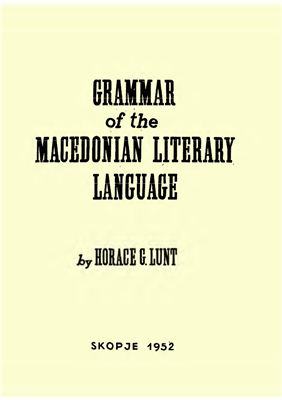Издательство: Skopje
Год выпуска: 1952
Количество страниц: 302
Формат: PDF
Язык: Английский
Цель книги выдающегося американского слависта - познакомить читателя с основами македонского литературного языка. В первой части описывается структура фонетического строя и морфологической системы языка, во второй части приводятся примеры прозаических текстов, последняя часть представляет собой краткий македонско-английский словарик. Прилагается также карта регионов Македонии.
It is the aim of this book to introduce the reader to the Macedonian literary language. The first part consists of a description of the structure of the sound patte and the morphological system of the language, the second part is made up of typical examples of Macedonian prose, and the last gives a representative list of Macedonian words with their English equivalents. This is the first attempt to present Macedonian entirely in its own terms. The current school grammar, MarcedoHcica zpcuiarttKa (1950), by Krume Kepeski, amounts to an adaptation from similar Bulgarian works, with many quite unnecessary comparative and historical references. The only extensive treatment of Macedonian in any other language is the sketch included in R. de Bray's Guide to the Slavonic Languages (London, 1950; pp. 243 313). De Bray took most of his information from Kepeski, and unfortunately included some of the latter's misinterpretations. In the Guide, Macedonian is explained exclusively from the comparative point of view, within the framework of the whole group of the Slavic languages. Other published works about Macedonian are only short articles enumerating the salient features of Macedonian as compared to the other Slavic languages.
Год выпуска: 1952
Количество страниц: 302
Формат: PDF
Язык: Английский
Цель книги выдающегося американского слависта - познакомить читателя с основами македонского литературного языка. В первой части описывается структура фонетического строя и морфологической системы языка, во второй части приводятся примеры прозаических текстов, последняя часть представляет собой краткий македонско-английский словарик. Прилагается также карта регионов Македонии.
It is the aim of this book to introduce the reader to the Macedonian literary language. The first part consists of a description of the structure of the sound patte and the morphological system of the language, the second part is made up of typical examples of Macedonian prose, and the last gives a representative list of Macedonian words with their English equivalents. This is the first attempt to present Macedonian entirely in its own terms. The current school grammar, MarcedoHcica zpcuiarttKa (1950), by Krume Kepeski, amounts to an adaptation from similar Bulgarian works, with many quite unnecessary comparative and historical references. The only extensive treatment of Macedonian in any other language is the sketch included in R. de Bray's Guide to the Slavonic Languages (London, 1950; pp. 243 313). De Bray took most of his information from Kepeski, and unfortunately included some of the latter's misinterpretations. In the Guide, Macedonian is explained exclusively from the comparative point of view, within the framework of the whole group of the Slavic languages. Other published works about Macedonian are only short articles enumerating the salient features of Macedonian as compared to the other Slavic languages.

